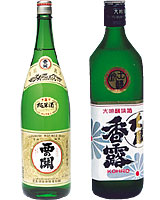Special Feature![]() Here’s to Japanese sake!
Here’s to Japanese sake!
Mapping Japan’s Treasure House of Sake
The Japanese archipelago stretches far from north to south, so it is only natural that each region has its own climate and cuisine. The raw materials used to make sake, mainly rice and kobo yeast, also differ somewhat by region, so the character of the Nihon-shu (Japanese sake) served with the local cuisine is somewhat different, as well. These two pages divide the country into 10 regions, and describe the distinctive characteristics of select brands of sake from each one.
Written by Eguchi Mayumi
- The following information is listed next to the circled numbers:
-
 Sake type
Sake type Sake Meter Value (SMV)
Sake Meter Value (SMV) Name of brewer
Name of brewer Prefecture where brewed
Prefecture where brewed Other distinguishing features
Other distinguishing features
Keys for understanding Japanese sake
- Nihon-shudo: Sake Meter Value (SMV), a measure of sweetness (ama-kuchi) or dryness (kara-kuchi). The sweeter the sake, the greater the minus value; the dryer the sake, the higher the plus value. The designations ama-kuchi and kara-kuchi express a number of factors, most notably the degree of sweetness, the acidity level (including the amino acid content), and the alcohol content.
- Tanrei: Refreshing taste
- Nojun: Mellow taste, rich and robust
- Tanrei kara-kuchi: Refreshing, dry taste
- Nojun uma-kuchi: Rich and robust, with a full-bodied taste
Hokkaido
The northern island of Hokkaido is cool in summer and cold in winter, so sake matures more slowly there. This generally makes for a smoother texture and a lighter taste. Brewers take advantage of the natural environment. For example: in the winter, some brewers get their water from ice floating in the Sea of Okhotsk; and in some places caves are carved out of snow banks several meters high, to make sake “cellars.”

Tohoku
Full-bodied, velvety sake is prominent in this region from Aomori Prefecture to northern Yamagata Prefecture. Akita Prefecture is the biggest producer in the Tohoku region. Many of the master brewers now plying their trade in Japan originally came from Tohoku’s Iwate Prefecture. Sake from Miyagi and Fukushima prefectures has a somewhat more refined character, although breweries in Fukushima’s Aizu district tend to favor a rich texture and a sweet taste.

Koshin’etsu
Niigata Prefecture is known for its refined, dry sake, and is the third largest center of production in Japan. Many breweries have won gold at the Zenkoku Shinshu Kanpyo-kai (a prestigious contest held to appraise newly brewed sake from throughout the country). Mountain ranges cut Nagano Prefecture off from the rest of the country, and the “Japan Alps yeast” produced here gives a distinctively fragrant character to Nagano sake. Sake from Yamanashi Prefecture is known for its pleasantly unassuming flavor.
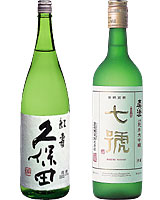
Kanto
Greater Tokyo, home to millions of discerning consumers, occupies a large part of the Kanto region, and much of the sake brewed here has a refreshing personality. Ibaraki has more sakagura breweries than any other prefecture in the region, and the area around the city of Ishioka is a well-known center of production.

Tokai
Shizuoka Prefecture is the best known center of production in the Tokai region, and much of the sake brewed there is of the ginjo-shu type, using Shizuoka yeast to create sake with a fruity flavor. The other three prefectures in the region produce sake with a pronounced, slightly sweet flavor. Sake from Aichi Prefecture has a mellow character, probably brewed that way to make it go well with the strongly seasoned local cuisine.
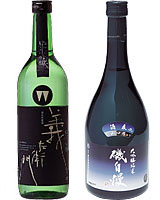
Hokuriku
Each prefecture in this region produces its own distinctive sake: Ishikawa’s is mellower, Toyama’s favors refinement, while Fukui’s tends more toward a smooth, velvety finish. The rich culinary culture of the old castle town of Kanazawa, which was the center of the bountiful rice-growing feudal province of Kaga, has retained its traditions since the Edo period (1603-1867) and greatly influenced sake brewing methods in Ishikawa Prefecture.
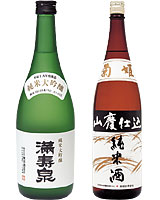
Kinki
Hyogo Prefecture is the largest center of production in Japan. It is also one of the best, with the Nada district famous for its sake since the Edo period (1603-1867). The Yamada Nishiki variety of rice, which is grown in the prefecture for the production of sake, deserves special mention. The premium miya-mizu water used in the Nada district is somewhat hard, yielding crisp, strong sake. On the other hand, the soft water used in the Fushimi district of Kyoto Prefecture, Japan’s second most important center of production, results in a velvety, high-quality sake. Osaka has been famous for its sake since the 1600s, and many breweries there still pride themselves on following traditional methods.
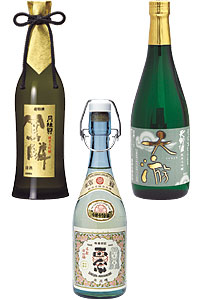
Chugoku
Hiroshima Prefecture produces a sweet sake with a mellow character. This makes it the complete opposite of the refined, dry sake of Niigata Prefecture, although both have won rave reviews at contests held to appraise sake from throughout the country. The Omachi variety of rice grown in Okayama Prefecture is considered as good for making sake as Yamada Nishiki. It yields a more robust beverage than the more delicate sake brewed from Yamada Nishiki rice.

Shikoku
Kochi Prefecture faces the Pacific Ocean and produces dry, robust sake with a friendly kick, whereas the other three prefectures face the Seto Inland Sea and produce sake with an entirely different character—delicate on the palate, sweet to the taste.

Kyushu & Okinawa
Kyushu is known for a distilled liquor called shochu (awamori in Okinawa). Even so, sake holds its own in this part of Japan, and Fukuoka has many sake breweries. Kumamoto Prefecture is home to the Kumamoto yeast, a vital component in the making of the ginjo-shu type of sake. Much of the sake brewed in Kyushu has a rich, sweet flavor, except for Kumamoto where dryness is favored.
